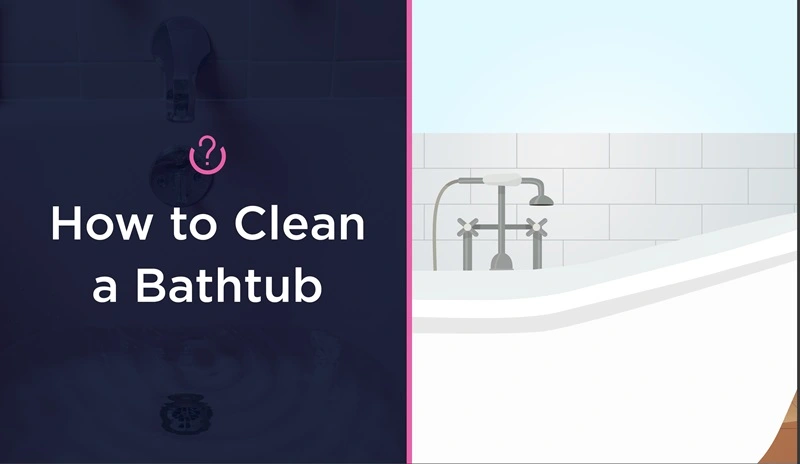
Last Updated: May 10, 2024
Who wants to take a relaxing soak in a dirty bathtub? No one. Ignoring a dirty tub only makes it harder to clean. A regular bathtub cleaning routine can turn a semiannual one-hour job into a quick and simple 10-minute job every month. Removing soap scum from your tub will also help your grout and glass stay cleaner for longer.
Table of Contents:
What is the Best Way to Clean a Bathtub?
When it comes to bathtub cleaning, there's a perfect solution for every grime situation. Here’s a helpful guide to help you navigate the world of cleaning products and techniques to achieve a sparkling, sanitary tub.
Evaluating Different Cleaning Solutions:
- Commercial Cleaners:
- Pros: Powerful, effective on tough stains, readily available.
- Cons: Can be harsh on surfaces, contain harmful chemicals, often have strong odors.
- Homemade Remedies:
- Pros: Eco-friendly, often less expensive, readily available ingredients (baking soda, vinegar).
- Cons: May not be as powerful on tough stains, require more scrubbing effort.
- Eco-Friendly Alternatives:
- Pros: Gentle on surfaces, better for the environment, often use plant-based ingredients.
- Cons: May require more frequent cleaning, might not be as readily available as commercial options.
Implementing Best Practices:
The best cleaning method depends on three key factors:
- Bathtub Material:
- Porcelain/Fiberglass: Most cleaning solutions are safe.
- Acrylic/Cast Iron: Avoid abrasive cleaners that can scratch the surface.
- Natural Stone: Use special cleaners designed for stone surfaces.
- Stain Severity:
- Light Soap Scum: Dish soap and water, baking soda paste.
- Mineral Deposits: Vinegar solution, commercial cleaner specifically for hard water stains.
- Personal Preferences:
- Time: Commercial cleaners may be faster, while homemade solutions require more scrubbing.
- Effort: Opt for eco-friendly or commercial cleaners if you prefer less scrubbing.
- Environmental Concerns: Choose eco-friendly options for a greener clean.
Here are some additional tips:
- Always test any cleaning solution on an inconspicuous area before applying it to the entire tub.
- Wear rubber gloves for protection, especially when using harsh chemicals.
- Ensure good ventilation when using strong cleaners or bleach.
- For stubborn stains, let the cleaning solution sit for some time before scrubbing.
- Rinse the tub thoroughly after cleaning to remove any residue.
- Don't forget to clean the shower head, faucet, and surrounding areas for a complete clean.
What Not to Use to Clean a Tub?
Sometimes, the most effective cleaning solution is knowing what to avoid. Here are some common culprits that can actually damage your tub’s surface and make it harder to keep clean in the long run:
Avoiding Abrasive Cleaners:
While tempting for tough stains, abrasive cleaners like scouring powders or harsh pastes are packed with tiny, gritty particles. These can scratch and dull the surface of your bathtub, especially on materials like acrylic or fiberglass. Over time, this creates a rough surface that's more prone to harboring dirt and grime, making cleaning even harder in the future.
Steer Clear of Harsh Chemicals:
Bleach, ammonia, and other powerful chemicals might seem like a quick fix for stubborn stains. However, they can be harsh on your skin and eyes, causing irritation and fumes. Additionally, these chemicals can damage the finish of your bathtub, leading to discoloration or weakening the material.
Caution Against Using Metal Scrubbers:
Metal scrubbers or wire brushes might seem like a good option for tackling tough stains, but they're like tiny knives on your bathtub surface. They can easily scratch and leave behind unsightly marks, compromising the smooth, pristine look of your tub.
By avoiding these cleaning don’ts, you'll be well on your way to a safe and effective cleaning routine for your bathtub.
Steps for Cleaning Your Bathtub
- Fill up a bucket with hot water, and pour the water all over the tub.
- Sprinkle baking soda on all tub surfaces. For extra-dirty tubs, use tub-and-tile cleaner instead.
- Fill your bucket with a half-gallon of hot water and two tablespoons of dish soap.
- Dip a scrub sponge or a stiff nylon brush into the bucket, and scrub all bathtub surfaces.
- Use the bucket to periodically rinse out the sponge or brush and to transfer soapy water into the tub.
- When cleaning especially dirty tubs or stains, sprinkle baking soda directly onto the sponge or brush after dipping it in your bucket solution, and scrub hard.
- Once you’re satisfied and the tub looks clean, use the bathtub hand sprayer or the bucket to rinse the tub.
- Finish up by polishing the tub faucet, drain and handles with a clean, dry cloth.
How to Clean Mold or Mildew from Your Bathtub
Is there mold or mildew in your tub? If so, start the bathtub cleaning process by filling a spray bottle with hot water and four tablespoons of bleach. Spray this solution onto the affected areas, and allow it to soak in. While the bleach is soaking in, sprinkle baking soda throughout the tub. Proceed to step three as outlined above.
Bathtub Cleaning Supplies
These supplies are all you need to get your bathtub shiny and clean!
- Clean bucket
- Dish soap
- Scrub brush
- Cloth or hand towel
- Sponge
- Baking soda
- Tub-and-tile cleaner (optional)
- Spray bottle and bleach (for mold and mildew only)
Tips for Cleaning Your Bathtub
- If you’re also cleaning the shower wall tiles, save the tub for last.
- Cleaning a tub shouldn’t be painful. Create a pad for your knees by folding a towel lengthwise several times.
- Slow drain? Sprinkle four tablespoons of baking soda into the drain, followed by two cups of vinegar. Once the bubbling stops, flush the drain with boiling water.
- Stubborn stain? Make a paste out of baking soda and water. Apply this to the stain, and let it set for a few hours. Wipe away the paste once it’s dry.
- Keep your bathtub drain clean and clear with a mesh drain catcher.
Professional Cleaning Services from Molly Maid
Once you’re finished, head to the Bathroom Cleaning page to learn how to clean your showerhead, glass shower door and more. Molly Maid knows your time is valuable. With our professional home cleaning services, we will clean your bathtub, your bathroom, and the rest of your house so you can spend your free time the way you want to.
Sometimes, life gets busy, and a more thorough clean is just what your bathroom needs. Molly Maid offers professional cleaning services that can tackle even the toughest bathtub grime. Whether you have guests coming to stay or just need a chore checked off of your list, their team is committed to using safe and effective methods to leave your bathroom better than they found it.
We offer one-time, occasional, and recurring cleaning services to work with your schedule. Find your local Molly Maid and request a cleaning service today!
FAQ About Cleaning a Bathtub
How do I clean a bathtub effectively?
To clean a bathtub effectively, start by removing any debris or residue from the surface. Then, apply a suitable cleaner, scrub the bathtub using a non-abrasive sponge or microfiber cloth, and rinse thoroughly with water. For stubborn stains, consider using specialized cleaning products or natural remedies like baking soda and vinegar.
Does hydrogen peroxide whiten bathtubs?
Yes, hydrogen peroxide can help whiten bathtubs by removing stains and discoloration. Simply apply hydrogen peroxide directly to the stained areas, let it sit for a few minutes, and then scrub the bathtub with a sponge or cloth before rinsing thoroughly.
Will bleach make my tub white again?
Bleach can be effective in whitening bathtubs by removing stains and killing mold and mildew. However, it's essential to use bleach carefully and follow safety precautions, such as wearing gloves and ensuring proper ventilation. Additionally, avoid using bleach on colored or acrylic bathtubs, as it may cause discoloration or damage.
How often should I clean my bathtub?
It's recommended to clean your bathtub regularly to prevent the buildup of grime, soap scum, and mold. Depending on usage and hygiene preferences, aim to clean your bathtub at least once a week or as needed to maintain cleanliness and hygiene.
Are there any eco-friendly cleaning alternatives for bathtubs?
Yes, several eco-friendly cleaning alternatives can effectively clean bathtubs without harsh chemicals. These include using natural ingredients such as baking soda, vinegar, lemon juice, or hydrogen peroxide. Additionally, eco-friendly cleaning products labeled as non-toxic and biodegradable can be used as alternatives to traditional cleaners.
 Click to call
Click to call




